The film-advance lever
simultaneously advances the film, cocks the shutter and operates the frame counter.
To advance the film, stroke the lever with the right thumb in a single stroke (or
series of strokes) totaling only 120°. At the completion of film advance, release
the lever and it will return to the 20° standoff position ready for shutter release.
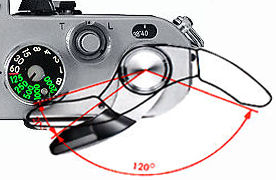 |
The lever can be operated in a single sweep or in a series of shorter strokes. A built-in locking device prevents accidental tripping of shutter before it has been fully cocked. The lever swings back after each stroke. A shorter stroke angle of a film winding lever would generally mean an increased winding torque. However, the Nikon F2's film advance lever uses ball bearings and special teflon bushing for smooth, light and easy operation. |
The tip of the lever is covered with plastic to improve its "feel" on the photographer's thumb. The film advance lever also serves as an on/off switch for the exposure meter of the Photomic finder.
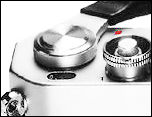 |
The meter is turned on by moving out the lever some 20° to reveal the meter switch index (red dot) beneath, and turned off by pressing it flush against the body. With DE-1 (or DE-1/T) attached, the red dot is meaningless. |
The Nikon F2 employs a six-slotted film take-up spool for secure and easy insertion of the film leader. The shaft for winding the film passes through the center of the spool.
Self-Timer
The self-timer permits
delayed exposures of up to 10 seconds. Marked with numerals 2, 4, 6, 8 and 10, it
sets the shutter for a delay of the number of seconds desired. It can also be used
for obtaining extra-slow shutter speeds of 2 to 10 seconds when used with some photomic
finder. The numbers
marked on the timer scale indicate the delay in seconds.
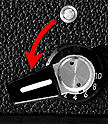 |
To take a picture using the self-timer to fire the camera, first set the aperture and shutter-speed controls, advance the film, and cock the self-timer by turning its lever downward until the index line (on the lever) aligns with the figure (on the scale) corresponding to the desired number of seconds delay; then, simply press the small button just above the timer to start the countdown, with shutter release occurring at the completion of the cycle. |
 |
Note: the self-timer can be set either before or after advancing film; also, if you decide not to use the self-timer after setting it, simply use the shutter button in the normal way to make the next exposure and to release the self-timer for resetting to the off position. The self-timer may not be used at the "B" shutter-speed dial setting. |
Unloading
Film Roll
When the frame counter indicates that the last exposure has been made, or when the
film-advance lever can no longer be stroked, the roll of film has been fully exposed
and it should be rewound.
To unload the film, first press the rewind button on the camera base plate; then, unfold the rewind crank, pull it up to the first detent position and turn it in the direction of the engraved arrow, using a smooth, even pressure.
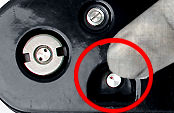 |
 |
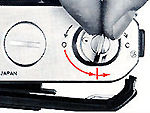 |
When no more tension is felt and the film advance indicator (the colored dot on the rewind button) stops rotating, the film leader has left the take-up spool and the camera back may be opened. |
After opening the camera
back, pull the rewind knob up as far as it will go and remove the film cartridge.
Note that as the film advance lever is stroked for the next exposure, the rewind
button will be released to engage the film-advance mechanism.
Caution: Be careful not to push the rewind
button during film advance operation. Should this occur, the film transport will
temporarily stop and double exposure may result. Note:
The camera back can be removed from the body by depressing the locking catch on the
hinge. Removal of the camera back is necessary when the camera is used with any accessory
back such as 250 Magazine Back MF-1 or the Camera Back MF-3, both for motorized photography.
Motor Drive MD-1 and MD-2 permits automatic power film rewind (NOT possible with MD-3).
| Previous | NEXT | 3 / 12 Viewfinder and Accessories
| Back | Index Page - Nikon F2
| Message Board | for
your favourite Nikon
F2 Series SLR model(s)
| Message Board | for your Nikon Optics in a shared environment
| Message Board | Specifically for Dispose or Looking for Nikon/Nikkor Photographic
Equipment
| Back |
to Main
Index Page of Nikon
F2 Series SLR models
| Back | Main Index Page of
Pictorial History of Nikon SLRs
 |
The Eyes of Nikon:- |
Fisheye-Nikkor Lenses - Circular | Full Frame | Ultrawides Lenses - 13mm15mm18mm20mm | Wideangle Lenses - 24mm28mm35mm |
Standard Lenses - 45mm 50mm 58mm | Telephoto Lenses - 85mm105mm135mm180mm & 200mm |
Super-Telephoto Lenses - 300mm 400mm 500mm 600mm 800mm 1200mm |
Special Application lenses:
Micro-Nikkor Lenses - 50mm~55mm -60mm 85mm -105mm 200mm Micro-Zoom 70-180mm
Perspective Control (PC) - 28mm 35mm PC-Micro 85mm
Dedicated Lenses for Nikon F3AF: AF 80mm f/2.8 | AF 200mm f/3.5 EDIF
Depth of Field Control (DC): 105mm 135mm
Medical Nikkor: 120mm 200mm
Reflex-Nikkor Lenses - 500mm 1000mm 2000mm
Others: Noct Nikkor | OP-Nikkor | UV Nikkor 55mm 105mm | Focusing Units | Bellows-Nikkor 105mm 135mm
Nikon Series E Lenses: 28mm35mm50mm100mm135mm | E-Series Zoom lenses: 36~72mm75~150mm70~210mm
MF Zoom-Nikkor Lenses: 25~50mm | 28~45mm | 28~50mm | 28~85mm | 35~70mm | 36~72mm E | 35~85mm | 35~105mm | 35~135mm |
35~200mm | 43~86mm | 50~135mm | 50~300mm | 70~210mm E | 75~150mm E | 80~200mm | 85~250mm |
100~300mm | 180~600mm | 200~400mm | 200~600mm | 360~1200mm | 1200~1700mm
Tele-Converters: TC-1 | TC-2 | TC-200 | TC-201 | TC-300 | TC-301 | TC-14 | TC-14A | TC-14B | TC-14C | TC-14E | TC-16 | TC-16A | TC-20E
![]()
Nikon F
| Nikon F2 |
Nikon
F3
| Nikon F4 |
Nikon
F5
| Nikon F6 |
Nikkormat / Nikomat |
Nikon FM
| Nikon FE/ FA | Nikon EM/FG/FG20 | Nikon Digital SLRs | Nikon - Other models
MIR Supports for Photographic Community: Various Message Boards/Community
Forums
Nikon
F-series|
Nikon
F2-series|
Nikon
F3-series|
Nikon F4-series| Nikon
F5-series|Nikkormat/Nikomat-series
Nikon FM-series|Nikon
FE-series|Nikon
FA|Nikon
Digital
SLR
series|Various
Nikon
Models|Nikkor
Optic
-shared
Others:- Free Trade Zone - Photography| Free Trade Zone - Business Community |Free To Zouk - Photographic Community
Apple's Mac Public Community Message Board | Windows based PC &
Apple/Mac
Public Community Trade Exchange Centre
Recommended links to understand
more technical details related to the Nikkor F-mount and production Serial Number:
http://rick_oleson.tripod.com/index-153.html by: my friend, Rick Oleson
http://www.zi.ku.dk/personal/lhhansen/photo/fmount.htm by: Hansen, Lars Holst
http://www.mir.com.my/rb/photography/hardwares/nikonfmount/lens2.htm
http://www.photosynthesis.co.nz/nikon/serialno.html
About this photographic site.
HOME - Photography in Malaysia |
Copyright © 2000. leofoo ®. MIR Web Development Team.
In
memory of my friend Com.
Augusto Staut,
Brazil, 1971-2000.
Credit: Chuck Hester, US for his patience, encouragement
and help to setup the various content in this site; Robert Johnson for some of his original
images on the F2H-MD appeared in this site; my ex-staff, KiaSu for his superb
3-D logo appeared in this Nikon F2 site; Marc Vorgers from Holland who
generously provide me with some of his images of F2AS; MCLau®, who has so much time with me to
re-edit the content in this site and not to mention buying a Nikon Coolpix 990 just
for this site. Keat Photo,
Kuala Lumpur for providing
their Nikon F2A to take some images for this site; again, Mr Edward Ngoh the
great camera collector who provides us his collection of F2AS with MD-2; hawkeye.photographic.com
for their images on the Speed Magny film backs; Sean Cranor for his image
on Nikon F2 25th Anniversary Model; Ted Wengelaar®, Holland for his continuous
flow of input on some of the early Nikon bodies; CYLeow ® , photo editor of the Star
newspaper, Malaysia for some of his images used in this site. Ms Rissa Chan, Sales manager from
Shriro Malaysia who has helped to provide some of the very useful input. HiuraShinsaku®,
Nikomat ML, Japan for some of his images on various F2 models; my staff, Wati, Maisa, Mai and my nephew, EEWyn®, who volunteered and helping me
did so many of the film scanning works. Contributing photographers or resellers:
Jen Siow, Foo KokKin, Arthur Teng, Mark Fallander, John
Ishii, Ed Hassel, YoonKi Kim, Jean-Louis, M.Dugentas (Dell Corner.com.), Mr "Arsenall" and a few images mailed
in from surfers with no appropriate reference to their origin. Dedicated to KU Yeo, just to express our mutual regrets over the outcome of
a recent corporate event. Made with a PowerMac, broadcast with a Redhat Linux powered server.
![]()
![]()